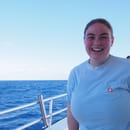*This article was originally published on Full Circle, Fall 2017*
Syeda Qudsia, a graduate from the National University of Sciences and Technology, (NUST), in Pakistan recently graduated with her MS in Nanoscience and Engineering. Qudsia spent a semester at Arizona State University, (ASU), studying and completing her master’s thesis using comics.
“I chose a comic strip format because it is a great medium for storytelling and it makes everything so much more interesting,” remarked Qudsia.
Qudsia was a part of the U.S.-Pakistan Centers for Advanced Studies in Energy, (USPCAS-E), a USAID project hosted at ASU. This program enables Pakistani students to focus on pertinent research towards Pakistan’s energy needs and aid in creating skilled graduates in the energy research.
Notoriously known for wearing Converse sneakers, she outlined what a pleasure it was to travel for the first time out of her country, work independently in ASU’s research culture, and spend extensive hours in the research facilities that she said are,“Quite impressive.”
Coming from a family where her mother studied geography and her father studied physics, Qudsia believes that going into the STEM field as a career choice was the only natural thing to do. “They (my family), are happy and quite content with it,” she said. She started her research looking at solar cells for her MS in Pakistan and then when coming to ASU decided to work on something new- silicon solar cells. Qudsia said that her new project was, “A breath of fresh air from my usual work.”
Her idea to use cartoons in her master’s thesis stemmed from the idea that most often science presentations are tedious and dull, and therefore, she wanted to do something that would break down the concepts while using creativity and innovation. Qudsia also chose comics to help people who are not familiar with her research or who are new to the field as way for them to easily learn concepts.
“I have attended countless science/research presentations, and most of the times, the presentation is just too technical, despite all efforts of the presenter to make it into an interesting story,” Qudsia admitted.
Her research began when she decided to use a carbon material known as graphene oxide in a solar cell called a, ‘Dye- Sensitized Solar Cell.’ Graphene was discovered in 2004, it is considered a relatively new material that is incredibly strong and has many electrical properties.
“We modified graphene oxide with a chemical compound, believing that it would change the electrical properties of the material. And it did, as we found out from some tests and measurements,” she said.
With further improvements, the modified compound might be able to replace platinum in Dye-Sensitized Solar Cells, which is a catalyst for a reaction that brings electrons, (a negatively charged particle within an atom), back to the cell from an exterior circuit. Platinum is an expensive material and therefore, it would be ideal to find a cheaper material that will catalyze the reaction just as well.
When her research concluded and she presented the idea, she felt like she was breaking the rules of what a science presentation traditionally should look like. However, Qudsia delightfully remarked that her presentation was well-received among her peers who appreciated the time and effort it took to pull it off. Qudsia thinks that there are several communication mediums that scientists can use other than traditional presentations in order to convey their research. She stated that, “Sometimes people cannot cover the gap-of-knowledge between the audience and the presenter. It just needs a little willingness and effort to simplify the concepts to convey the science behind the research.”
Qudsia continues to push norms by pursuing her dreams in a STEM career despite feeling like sometimes she is underestimated. “I keep my head down and work hard, and I have found these kinds of attitudes and feelings change and go away if you stay true to the field.”
Currently, Qudsia is in the process of applying for a PhD position in solar cell research and hopes to contribute to the field. She believes that the future of energy studies relies heavily on the study of nanoscience. Qudsia concluded that she is grateful for the USPCAS-E program at ASU, as it offered many opportunities for her to grow personally and professionally.


